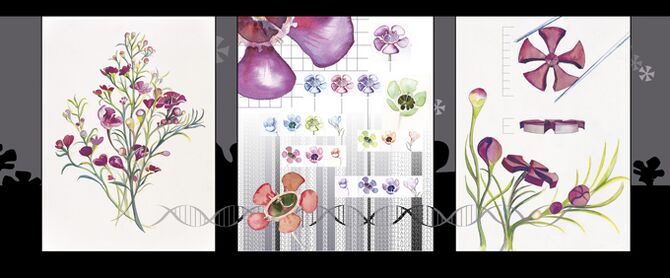20.109(F11): Mod 3 Day 4 Solar cell assembly
Solar Cell Assembly
Introduction
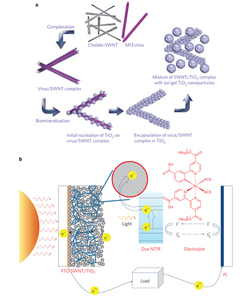
The principle of our dye-sensitized solar cells is that light absorption by a dye will provide the energy necessary to transfer its electrons to a mixture of Titania and Titania coated single walled carbon nano-tube(SWNT):phage complexes, which will act as a shuttle to deliver the electrons to an external circuit for extraction of "useful" energy. To complete the cell an Iodide redox mediator is used to recycle electrons back to the dye from a counter-electrode. During the first two lab sessions of this third module, you worked to coat genetically-modified M13 phage with SWNTs and to mineralize TiO2 upon them. (These steps are summarized visually in the top of the figure to the right) For today's session, you will use these complexes to construct the anode of the dye-sensitized solar cell. (The anode can be seen in the bottom left of the image to the right)
Protocols
While You Were Out
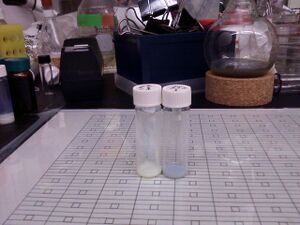
The TiO2 mineralized SWNT:phage complexes that you left last time were dried in a vacuum oven at room temperature. The dried substance was then ground, using a mortar and pestle, into a powder on the micrometer scale. To this ground material, a paste of pure TiO2, ethyl cellulose (for viscosity) and terpineol (an organic solvent) was added. To the right can be seen the image of the paste before the SWNT:Titania powder was added (left) and after (right).
The base of the anode has also been prepared. It consists of a piece of glass coated on one side with 2mm of Florine-doped Tin Oxide (FTO). Doping is the controlled introduction of impurities into an extremely pure semiconductor for the purpose of adjusting an electrical property of interest. In this case, the Tin Oxide has been doped with Florine for the purpose of increasing its conductance. After several cleaning steps, this base was incubated in a solution of TiCl4, a step designed to coat it with TiO2; this step is necessary for high efficiency performance of the device.
Part 1:
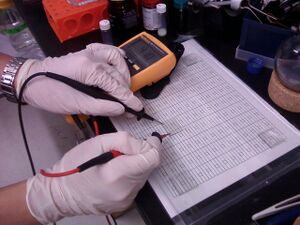
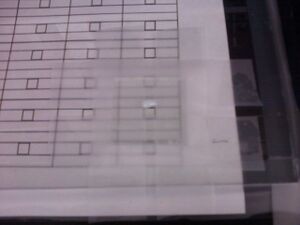
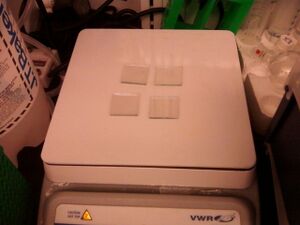
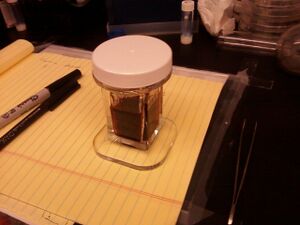
- Use a resistance meter to determine which side of a prepared glass anode base contains the layer of TiO2 coated FTO. The coated side of interest should have a measurable level of resistance while the pure glass side should not.
- With the coated side up, align your glass anode base onto a gridded template containing a 4mm x 4mm square so that the square appears in the center of the base.
- Using scotch tape, create a "well" the size of the 4mm X 4mm square by taping everywhere on the glass except the small square. (One piece on each side and one on the top and bottom should suffice.) Because the thickness of the tape is consistent (~50 micrometers), this method is a simple way to make uniformly sized solar cells.
- Using a , paint a small amount of the Titania paste that contains SWNT:Titania powder onto the top of the well. The amount you use should be roughly equivalent to the amount seen on the photo to the right.
- Spread the paste evenly throughout the well using a glass rod as if you were rolling out dough with a rolling pin. This process is known as "doctor blading". Once spread, let the device sit for about 3 minutes; this helps reduce the surface irregularity of the paste.
- Carefully remove the tape from around the well and dry the glass device on a hot plate set to ~120°C for 5 minutes.
- Safely remove the coated glass from the hot plate and transfer it to an oven in the fume hood that will anneal the sample at 600°C for 30 minutes. At the end of this annealing step, the thickness of the coating you added should be ~7-8 micrometers.
- The desired thickness of the photoanode is ~15 micrometers, so repeat steps 3 - 7 in order to achieve this.
- After letting the device cool from the annealing stage, immerse it in an Ru620 dye solution that contains 1:1 acetonitrile and tert-butyl alcohol. This will be left at room temperature until the next lab session where the counter electrode along with the completed device will be assembled and tested.
Part 2:
The groups not visiting the Belcher lab should use the extra time to work on their research proposals. These will be presented in just one week!!
For Next Time
- You should be well on your way to your final presentations of a research idea. Review the required elements for your presentation that are noted here.
